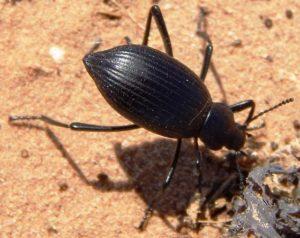The desert stink beetle is a genus of beetles belonging to the family of darkling beetles. They are known for producing a liquid with a pungent stench, and are native to the deserts of North America.
Size: 0.4-1.4 in (1-4 cm)
Color: These beetles are black, though shading varies from species to species.
Other Characteristic Features: The structure of the beetle’s bodies varies from rough to smooth. In some species, wings are elongated to the point of being mistaken for a tail; however, as their elytra are fused shut, they cannot fly. Some beetles have setae-like structures on their bodies and limbs.
As a form of defense, these beetles are known to stand on their heads and squirt a foul-smelling liquid at their perceived threat. Larger members of this genus are known to spray up to distances of 10-20 inches.
They are brown to darkish green, with slender, rigid bodies that give off a bit of sparkle. The larvae of some species are often called false wireworms.
The pupa has a dull yellowish-white appearance, measuring around 2 cm.
The female of certain species of this beetle can lay up to 100 eggs in soft soil, first in spring and then again a second batch during summer.
| Other names | Pinacate beetles, stink beetles, clown bugs, stink bugs, headstand beetle, skunk beetle |
| Lifespan | Over 1 year |
| Distribution | Western North America, particularly the Sonoran Desert |
| Habitat | Mountainous regions and scrublands |
| Predators | Burrowing owls, grasshopper mice, loggerhead shrikes, and skunks |
| Seasons active | Year-round |
| Host Plants | Detritus and under logs of dead plants |
| Diet of adults | Remains and waste of animals and plants |

The larvae are a pest to certain commercial crops, as they feed on the seeds and seedlings of crops such as cereals, grain legumes, oilseeds, sorghum, and wheat. Crops like canola and linola are the most at risk.
The liquid sprayed by the adults usually is painless but can cause temporary blindness if the eye is hit and causes a burning sensation if it goes into the mouth. The stench also cannot be washed off.
Image Source: postregister.com, amazonaws.com, desertusa.com, qph.fs.quoracdn.net, bugguide.net, a4.pbase.com,
The desert stink beetle is a genus of beetles belonging to the family of darkling beetles. They are known for producing a liquid with a pungent stench, and are native to the deserts of North America.
Size: 0.4-1.4 in (1-4 cm)
Color: These beetles are black, though shading varies from species to species.
Other Characteristic Features: The structure of the beetle’s bodies varies from rough to smooth. In some species, wings are elongated to the point of being mistaken for a tail; however, as their elytra are fused shut, they cannot fly. Some beetles have setae-like structures on their bodies and limbs.
As a form of defense, these beetles are known to stand on their heads and squirt a foul-smelling liquid at their perceived threat. Larger members of this genus are known to spray up to distances of 10-20 inches.
They are brown to darkish green, with slender, rigid bodies that give off a bit of sparkle. The larvae of some species are often called false wireworms.
The pupa has a dull yellowish-white appearance, measuring around 2 cm.
The female of certain species of this beetle can lay up to 100 eggs in soft soil, first in spring and then again a second batch during summer.
| Other names | Pinacate beetles, stink beetles, clown bugs, stink bugs, headstand beetle, skunk beetle |
| Lifespan | Over 1 year |
| Distribution | Western North America, particularly the Sonoran Desert |
| Habitat | Mountainous regions and scrublands |
| Predators | Burrowing owls, grasshopper mice, loggerhead shrikes, and skunks |
| Seasons active | Year-round |
| Host Plants | Detritus and under logs of dead plants |
| Diet of adults | Remains and waste of animals and plants |

The larvae are a pest to certain commercial crops, as they feed on the seeds and seedlings of crops such as cereals, grain legumes, oilseeds, sorghum, and wheat. Crops like canola and linola are the most at risk.
The liquid sprayed by the adults usually is painless but can cause temporary blindness if the eye is hit and causes a burning sensation if it goes into the mouth. The stench also cannot be washed off.
Image Source: postregister.com, amazonaws.com, desertusa.com, qph.fs.quoracdn.net, bugguide.net, a4.pbase.com,